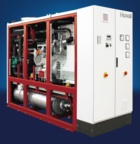Putting energy at the centre

The ability of centralised energy centres to reduce carbon emissions is one of the reasons for their growing popularity. They bring clear environmental benefits but it is important to ensure that centralised heating plant is designed to give maximum energy efficiency with minimum carbon emissions. Geoff Lord explains.
Many projects these days are opting for central energy plant serving a range of buildings. These ‘energy centres’ supply heat, power and, sometimes, chilled water from one location and distributed via a network of pipes and cables.
Such projects will typically incorporate combined heat and power (CHP) along with additional heat sources. The challenge for the building-services specifier is the critical task of configuring the various heat sources for optimum performance. This article explores some of the key considerations.
Of course, energy centres are nothing new, and there have been a few large-scale district-heating/energy schemes in the UK for many years. Some use CHP to meet part of the heating load while others simply take advantage of the efficiencies of scale of using large high-temperature hot-water or steam boilers to serve more than one building.
Ironically, though, in the 1980s and 1990s there was a tendency to decentralise heating plant and move towards more localised generation of hot water for heating and domestic hot water, using smaller plant. At the time this was deemed to offer the highest efficiency and a better response to modulating loads.
A number of factors have now combined to alter that perception. For example, well-designed gas, oil and biomass boilers now make it possible to achieve high efficiencies at part loads, particularly when used with modern, sophisticated controls. In addition, there is now a wider choice of heat sources — solar thermal and heat pumps being obvious examples — that can be combined with CHP and boilers and configured to give the best results for each project.
In parallel, there are many more financial and legislative pressures to make use of low- or zero-carbon heat sources. These include Part L of the Building Regulations, the Code for Sustainable Homes, the Carbon Reduction Commitment Energy Efficiency Scheme and local planning requirements — to name but a few.
Newer heating plant also makes it possible to apply these principles to smaller projects than may have been the case a few years ago. So we can expect to see more CHP-based district-energy schemes in housing developments, retail centres, industrial parks and commercial complexes — all of which have different heat load patterns and different requirements of their heating plant.
A mixed commercial and residential development, for example, will have a relatively consistent base heat load as demand moves from commercial premises in the day to dwellings in the evening. In contrast, a housing development will have its highest heat demands in early morning, evening and weekends, with relatively low demand at other times.

So, as noted earlier, the design parameters for the projected usage and seasonal variation are clearly important and where the plant room space permits, selecting CHP, biomass boilers or both for their optimum efficiency at full output would be the correct selection for maintaining the base load.
For example, the CHP unit could be sized on its thermal output to achieve a constant base load throughout the year, with the power generated being used on site, exported to the grid, or both. A biomass boiler could also be added to accommodate the increased base load as heating systems are switched on during colder periods. This arrangement provides a very efficient solution for accommodating the variation in base loads through the year, making maximum use of low-carbon technologies. Including biomass also enables the end client to take advantage of payments through the Renewable Heat Incentive (RHI).
However, it is also important to make provision for peak loads, over and above these seasonal base loads. Clearly, this provision needs to be highly responsive and able to offer high efficiency at variable heating loads while maintaining constant flow temperatures. One obvious solution is to incorporate fully modulating gas or oil boilers as these will achieve optimum efficiency at low firing and are more responsive to load variations than biomass boilers.
If the energy centre is also producing DHW then high-output calorifiers with minimal storage or plate heat exchangers feeding into stainless-steel buffer vessels should be considered. In this situation, it may also be beneficial to install solar-thermal systems to pre-heat the cold mains water feeding the calorifiers/buffer vessels to further enhance the overall operational efficiency of the energy centre. Again, solar thermal will bring further cost savings through the RHI. And there may be potential for including heat pumps in the mix of heating technologies for further efficiencies.
When designed and commissioned properly, such multi-source energy centres have the potential to reduce emissions and costs significantly. The key thing is to ensure that all the systems work efficiently together, so it makes a great deal of sense to source the entire package from a single supplier that can also provide technical support from design through to everyday operation.
*Geoff Lord is national business development manager with Hoval.








